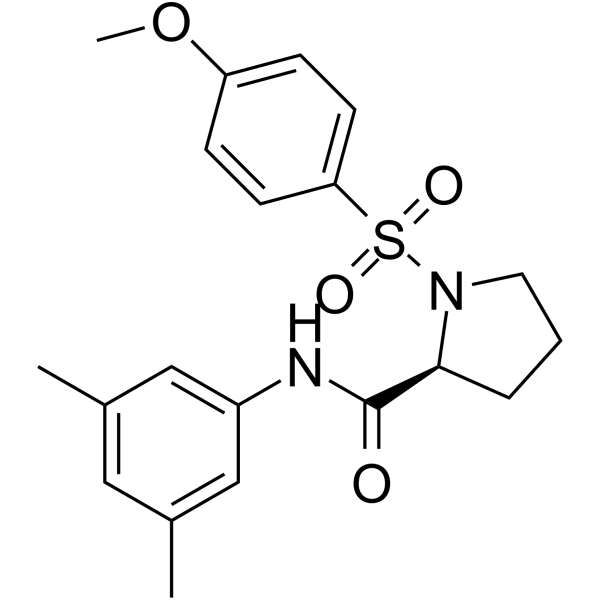ACT 462206
Modify Date: 2025-08-26 01:06:12

ACT 462206 structure
|
Common Name | ACT 462206 | ||
|---|---|---|---|---|
| CAS Number | 1361321-96-1 | Molecular Weight | 388.48100 | |
| Density | N/A | Boiling Point | N/A | |
| Molecular Formula | C20H24N2O4S | Melting Point | N/A | |
| MSDS | Chinese USA | Flash Point | N/A | |
| Symbol |

GHS07 |
Signal Word | Warning | |
Use of ACT 462206ACT-462206 is an orally active and potent dual Orexin 1/Orexin 2 receptor antagonist with IC50s of 60 nM (Orexin 1) and 11 nM (Orexin 2), respectively. ACT-462206 exhibits brain penetration properties, and can be used for insomnia, stress/anxiety-related disorders and addiction research[1]. |
| Name | (S)-1-(4-methoxy-benzenesulfonyl)-pyrrolidine-2-carboxylicacid (3,5-dimethyl-phenyl)-amide |
|---|---|
| Synonym | More Synonyms |
| Description | ACT-462206 is an orally active and potent dual Orexin 1/Orexin 2 receptor antagonist with IC50s of 60 nM (Orexin 1) and 11 nM (Orexin 2), respectively. ACT-462206 exhibits brain penetration properties, and can be used for insomnia, stress/anxiety-related disorders and addiction research[1]. |
|---|---|
| Related Catalog | |
| Target |
OX2 OX1 |
| In Vitro | Orexins are released in a Ca2+-sensitive manner at axonal terminals and can then bind to two closely related G-protein-coupled receptors (GPCRs): orexin receptor type 1 (OX1) and orexin receptor type 2 (OX2)[1]. ACT-462206 shows binding affinity with Kbs of 17 nM (hOX1), 2.4 nM (hOX2), 28 nM (rOX1), 9.9 nM (rOX2), 27 nM (dOX1), 4.2 nM (dOX2), respectively[1]. ACT-462206 inhibits Orexin activity with IC50s of 60 nM (hOX1), 11 nM (hOX2), 48 nM (rOX1), 9.6 nM (rOX2), 68 nM (dOX1), 26 nM (dOX2), respectively[1]. ACT-462206 inhibits CYP450 3A4T and 3A4M with IC50s of 15 μM and 29 μM, respectively[1]. |
| In Vivo | ACT-462206 (compound 24) (100 mg/kg; p.o.; sampling at 3 h) can go cross blood brain barrier, with concentrations are 2267 ng/mL and 1219 ng/g in plasma and brain, respectively in male Wistar rats[1]. ACT-462206 (10-300 mg/kg; p.o.; single dose) shows sleep-promoting effects in male Wistar rats and in male Beagle dogs, with decreasing wakefulness and increasing non-rapid eye movement (non-REM) and REM sleep[1]. ACT-462206 (100, 300 mg/kg; p.o.; single dose) exerts anxiolytic-like effects, decreases the fear-potentiated startle reflexes in response to a sudden loud noise in rats, reduces the socialstress-induced increases of locomotion, body temperature, and heart rate[1]. Pharmacokinetics in different species[1] Route Dose (mg/kg) AUC (ng•h/mL) CL (mL/min/kg) Vss (L/kg) t1/2 (h) cmax (ng/mL) tmax (h) F1/2 (%) rat i.v. 1 586 29 1.8 1.9 / / / p.o. 10 2310 / / / 1600 0.5 39 dog i.v. 1 1490 11 1.4 1.7 / / / p.o. 3 2750 / / / 426 0.5 52 Animal Model: Male Wistar rats[1] Dosage: 0, 10, 30, 100, 300 mg/kg Administration: Oral gavage; single dose Result: Decreased the latency to the first persistent episode of non-REM sleep (60 s) and the first persistent episode of REM sleep (30 s). Dose-dependently decreased total wake time and behavioral home cage activity (one-way ANOVA; p <0.001), while increasing REM and non-REM sleep times. |
| References |
| Molecular Formula | C20H24N2O4S |
|---|---|
| Molecular Weight | 388.48100 |
| Exact Mass | 388.14600 |
| PSA | 84.09000 |
| LogP | 4.19550 |
| Storage condition | 2-8°C |
| Symbol |

GHS07 |
|---|---|
| Signal Word | Warning |
| Hazard Statements | H302 |
| Precautionary Statements | P301 + P312 + P330 |
| RIDADR | NONH for all modes of transport |
| (S)-1-(4-methoxybenzenesulfonyl)pyrrolidine-2-carboxylic acid (3,5-dimethylphenyl)amide |
| (S)-N-(3,5-dimethylphenyl)-1-((4-methoxyphenyl)sulfonyl)-pyrrolidine-2-carboxamide |
| (S)-N-(3,5-dimethylphenyl)-1-((4-methoxyphenyl)sulfonyl)pyrrolidine-2-carboxamide |